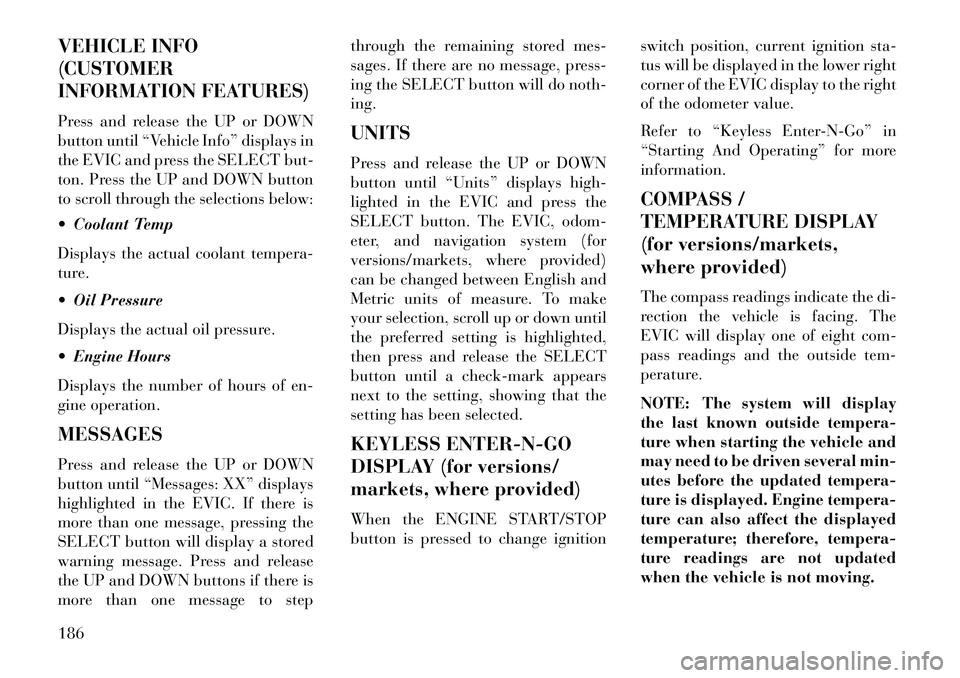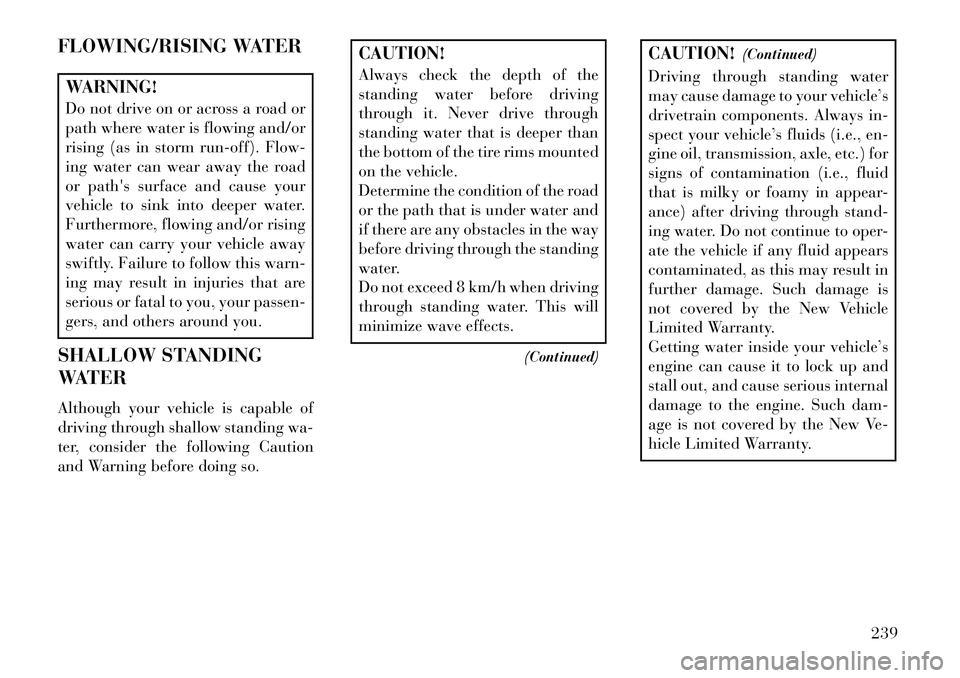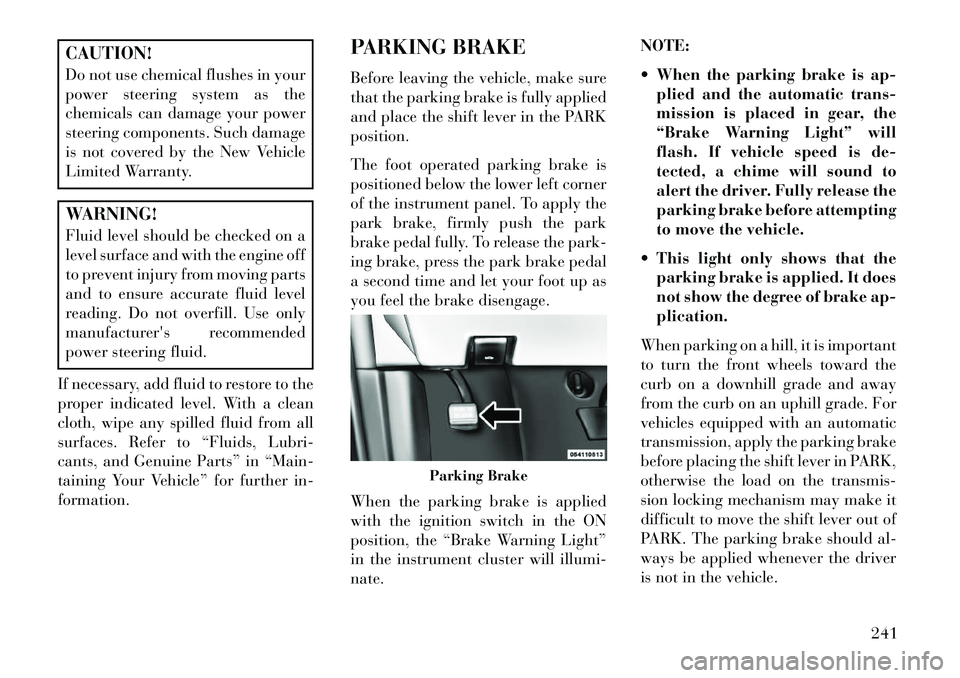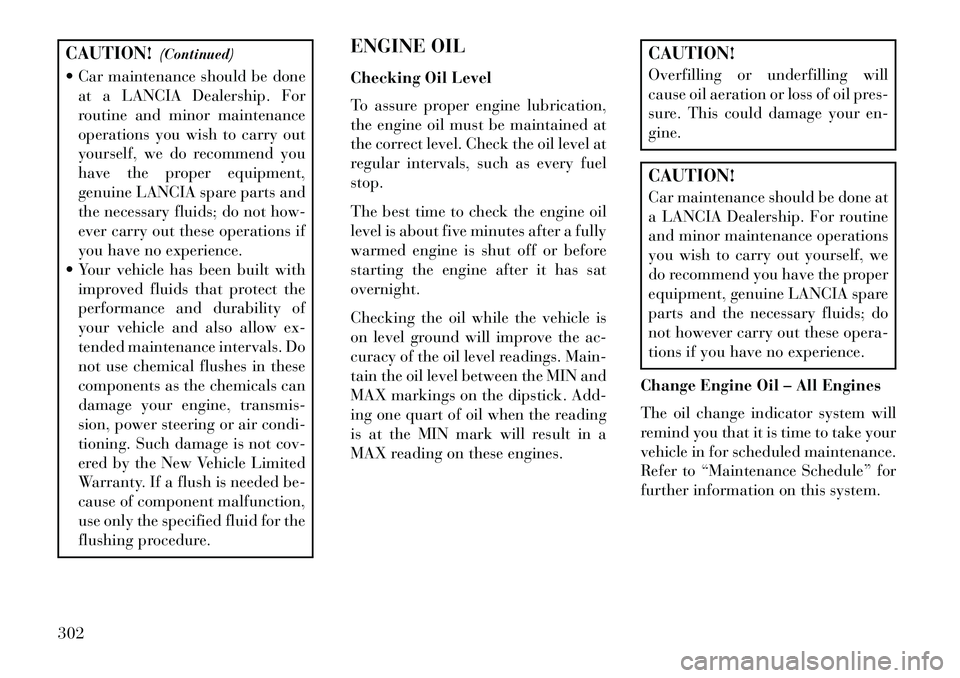check engine Lancia Voyager 2013 Owner handbook (in English)
[x] Cancel search | Manufacturer: LANCIA, Model Year: 2013, Model line: Voyager, Model: Lancia Voyager 2013Pages: 360, PDF Size: 4.21 MB
Page 192 of 360

VEHICLE INFO
(CUSTOMER
INFORMATION FEATURES)
Press and release the UP or DOWN
button until “Vehicle Info” displays in
the EVIC and press the SELECT but-
ton. Press the UP and DOWN button
to scroll through the selections below:
Coolant Temp
Displays the actual coolant tempera-
ture.
Oil Pressure
Displays the actual oil pressure.
Engine Hours
Displays the number of hours of en-
gine operation.
MESSAGES
Press and release the UP or DOWN
button until “Messages: XX” displays
highlighted in the EVIC. If there is
more than one message, pressing the
SELECT button will display a stored
warning message. Press and release
the UP and DOWN buttons if there is
more than one message to stepthrough the remaining stored mes-
sages. If there are no message, press-
ing the SELECT button will do noth-
ing.
UNITS
Press and release the UP or DOWN
button until “Units” displays high-
lighted in the EVIC and press the
SELECT button. The EVIC, odom-
eter, and navigation system (for
versions/markets, where provided)
can be changed between English and
Metric units of measure. To make
your selection, scroll up or down until
the preferred setting is highlighted,
then press and release the SELECT
button until a check-mark appears
next to the setting, showing that the
setting has been selected.
KEYLESS ENTER-N-GO
DISPLAY (for versions/
markets, where provided)
When the ENGINE START/STOP
button is pressed to change ignition
switch position, current ignition sta-
tus will be displayed in the lower right
corner of the EVIC display to the right
of the odometer value.
Refer to “Keyless Enter-N-Go” in
“Starting And Operating” for more
information.
COMPASS /
TEMPERATURE DISPLAY
(for versions/markets,
where provided)
The compass readings indicate the di-
rection the vehicle is facing. The
EVIC will display one of eight com-
pass readings and the outside tem-
perature.
NOTE: The system will display
the last known outside tempera-
ture when starting the vehicle and
may need to be driven several min-
utes before the updated tempera-
ture is displayed. Engine tempera-
ture can also affect the displayed
temperature; therefore, tempera-
ture readings are not updated
when the vehicle is not moving.
186
Page 245 of 360

FLOWING/RISING WATERWARNING!
Do not drive on or across a road or
path where water is flowing and/or
rising (as in storm run-off). Flow-
ing water can wear away the road
or path's surface and cause your
vehicle to sink into deeper water.
Furthermore, flowing and/or rising
water can carry your vehicle away
swiftly. Failure to follow this warn-
ing may result in injuries that are
serious or fatal to you, your passen-
gers, and others around you.
SHALLOW STANDING
WATER
Although your vehicle is capable of
driving through shallow standing wa-
ter, consider the following Caution
and Warning before doing so.
CAUTION!
Always check the depth of the
standing water before driving
through it. Never drive through
standing water that is deeper than
the bottom of the tire rims mounted
on the vehicle.
Determine the condition of the road
or the path that is under water and
if there are any obstacles in the way
before driving through the standing
water.
Do not exceed 8 km/h when driving
through standing water. This will
minimize wave effects. (Continued)
CAUTION!(Continued)
Driving through standing water
may cause damage to your vehicle’s
drivetrain components. Always in-
spect your vehicle’s fluids (i.e., en-
gine oil, transmission, axle, etc.) for
signs of contamination (i.e., fluid
that is milky or foamy in appear-
ance) after driving through stand-
ing water. Do not continue to oper-
ate the vehicle if any fluid appears
contaminated, as this may result in
further damage. Such damage is
not covered by the New Vehicle
Limited Warranty.
Getting water inside your vehicle’s
engine can cause it to lock up and
stall out, and cause serious internal
damage to the engine. Such dam-
age is not covered by the New Ve-
hicle Limited Warranty.
239
Page 246 of 360

WARNING!
Driving through standing waterlimits your vehicle’s traction ca-
pabilities. Do not exceed 8 km/h
when driving through standing
water.
Driving through standing water
limits your vehicle’s braking ca-
pabilities, which increases stop-
ping distances. Therefore, after
driving through standing water,
drive slowly and lightly press on
the brake pedal several times to
dry the brakes.
Getting water inside your vehi-
cle’s engine can cause it to lock up
and stall out, and leave you
stranded.
Failure to follow these warnings may result in injuries that are se-
rious or fatal to you, your passen-
gers, and others around you. POWER STEERING
The standard power steering system
will give you good vehicle response
and increased ease of maneuverability
in tight spaces. The system will pro-
vide mechanical steering capability if
power assist is lost.
If for some reason the power assist is
interrupted, it will still be possible to
steer your vehicle. Under these condi-
tions, you will observe a substantial
increase in steering effort, especially
at very low vehicle speeds and during
parking maneuvers.
NOTE:
Increased noise levels at the end
of the steering wheel travel are
considered normal and do not
indicate that there is a problem
with the power steering system.
Upon initial start-up in cold weather, the power steering
pump may make noise for a
short amount of time. This is due
to the cold, thick fluid in the
steering system. This noise
should be considered normal, and it does not in any way dam-
age the steering system.
WARNING!
Continued operation with reduced
power steering assist could pose a
safety risk to yourself and others.
Service should be obtained as soon
as possible.CAUTION!
Prolonged operation of the steering
system at the end of the steering
wheel travel will increase the steer-
ing fluid temperature and it should
be avoided when possible. Damage
to the power steering pump may
occur.
POWER STEERING FLUID
CHECK
Checking the power steering fluid
level at a defined service interval is
not required. The fluid should only be
checked if a leak is suspected, abnor-
mal noises are apparent, and/or the
system is not functioning as antici-
pated. Coordinate inspection efforts
through an authorized dealer.
240
Page 247 of 360

CAUTION!
Do not use chemical flushes in your
power steering system as the
chemicals can damage your power
steering components. Such damage
is not covered by the New Vehicle
Limited Warranty.WARNING!
Fluid level should be checked on a
level surface and with the engine off
to prevent injury from moving parts
and to ensure accurate fluid level
reading. Do not overfill. Use only
manufacturer's recommended
power steering fluid.
If necessary, add fluid to restore to the
proper indicated level. With a clean
cloth, wipe any spilled fluid from all
surfaces. Refer to “Fluids, Lubri-
cants, and Genuine Parts” in “Main-
taining Your Vehicle” for further in-
formation. PARKING BRAKE
Before leaving the vehicle, make sure
that the parking brake is fully applied
and place the shift lever in the PARK
position.
The foot operated parking brake is
positioned below the lower left corner
of the instrument panel. To apply the
park brake, firmly push the park
brake pedal fully. To release the park-
ing brake, press the park brake pedal
a second time and let your foot up as
you feel the brake disengage.
When the parking brake is applied
with the ignition switch in the ON
position, the “Brake Warning Light”
in the instrument cluster will illumi-
nate.NOTE:
When the parking brake is ap-
plied and the automatic trans-
mission is placed in gear, the
“Brake Warning Light” will
flash. If vehicle speed is de-
tected, a chime will sound to
alert the driver. Fully release the
parking brake before attempting
to move the vehicle.
This light only shows that the parking brake is applied. It does
not show the degree of brake ap-
plication.
When parking on a hill, it is important
to turn the front wheels toward the
curb on a downhill grade and away
from the curb on an uphill grade. For
vehicles equipped with an automatic
transmission, apply the parking brake
before placing the shift lever in PARK,
otherwise the load on the transmis-
sion locking mechanism may make it
difficult to move the shift lever out of
PARK. The parking brake should al-
ways be applied whenever the driver
is not in the vehicle.
Parking Brake
241
Page 280 of 360

WARNING!
Improper towing can lead to an in-
jury accident. Follow these guide-
lines to make your trailer towing as
safe as possible:
Make certain that the load is se-cured in the trailer and that it will
not shift during travel. When
trailering cargo that is not fully
secured, dynamic load shifts can
occur that may be difficult for the
driver to control. You could lose
control of your vehicle and have
an accident.
All trailer hitches should be pro- fessionally installed on your ve-
hicle.
When hauling cargo or towing a
trailer, do not overload your ve-
hicle or trailer. Overloading can
cause a loss of control, poor per-
formance, or damage to brakes,
axle, engine, transmission, steer-
ing, suspension, chassis structure,
or tires.
(Continued)
WARNING!(Continued)
Safety chains must always be used between your vehicle and
trailer. Always connect the chains
to the frame or hook retainers of
the vehicle hitch. Cross the chains
under the trailer tongue and al-
low enough slack for turning cor-
ners.
Vehicles with trailers should not
be parked on a grade. When
parking, apply the parking brake
on the tow vehicle. Always, block
or "chock" the trailer wheels.
GCWR must not be exceeded.
Total weight must be distrib-
uted between the tow vehicle
and the trailer such that the
following four ratings are not
exceeded:
1. GVWR
2. GTW
3. GAWR
4. Tongue weight rating for the
trailer hitch utilized. Towing Requirements – Tires
Do not attempt to tow a trailer
while using a compact spare tire.
Proper tire inflation pressures are essential for the safe and satisfac-
tory operation of your vehicle. Re-
fer to “Tires – General Informa-
tion” in “Starting and Operating”
for proper tire inflation procedures.
Check the trailer tires for proper tire inflation pressures before
trailer usage.
Check for signs of tire wear or vis- ible tire damage before towing a
trailer. Refer to “Tires – General
Information” in “Starting and Op-
erating” for the proper inspection
procedure.
When replacing tires, refer to “Tires – General Information” in “Start-
ing and Operating” for proper tire
replacement procedures. Replacing
tires with a higher load carrying
capacity will not increase the vehi-
cle's GVWR and GAWR limits.
274
Page 297 of 360

Vehicles Without Wheel Covers
1. Mount the road tire on the axle.
2.
Install the remaining lug nuts with
the cone shaped end of the nut toward
the wheel. Lightly tighten the lug nuts.WARNING!
To avoid the risk of forcing the ve-
hicle off the jack, do not tighten the
wheel nuts fully until the vehicle
has been lowered. Failure to follow
this warning may result in personal
injury.
3. Lower the vehicle to the ground by
turning the jack handle counterclock-
wise.
4. Finish tightening the lug nuts.
Push down on the wrench while at the
end of the handle for increased lever-
age. Tighten the lug nuts in a star
pattern until each nut has been tight-
ened twice. The correct tightness of
each lug nut is 138 N·m. If in doubt
about the correct tightness, have them
checked with a torque wrench by your
authorized dealer or service station. 5. After 40 km check the lug nut
torque with a torque wrench to ensure
that all lug nuts are properly seated
against the wheel.
JUMP-STARTING
If your vehicle has a discharged bat-
tery it can be jump-started using a set
of jumper cables and a battery in an-
other vehicle or by using a portable
battery booster pack. Jump-starting
can be dangerous if done improperly
so please follow the procedures in this
section carefully.
NOTE: When using a portable
battery booster pack follow the
manufacturer’s operating instruc-
tions and precautions.
CAUTION!
Do not use a portable battery
booster pack or any other booster
source with a system voltage
greater than 12 Volts or damage to
the battery, starter motor, alterna-
tor or electrical system may occur.
WARNING!
Do not attempt jump-starting if the
battery is frozen. It could rupture or
explode and cause personal injury.
PREPARATIONS FOR
JUMP-START
The battery in your vehicle is located
on the left side of the engine compart-
ment.
Positive Battery Post
291
Page 308 of 360

CAUTION!(Continued)
Car maintenance should be done at a LANCIA Dealership. For
routine and minor maintenance
operations you wish to carry out
yourself, we do recommend you
have the proper equipment,
genuine LANCIA spare parts and
the necessary fluids; do not how-
ever carry out these operations if
you have no experience.
Your vehicle has been built with improved fluids that protect the
performance and durability of
your vehicle and also allow ex-
tended maintenance intervals. Do
not use chemical flushes in these
components as the chemicals can
damage your engine, transmis-
sion, power steering or air condi-
tioning. Such damage is not cov-
ered by the New Vehicle Limited
Warranty. If a flush is needed be-
cause of component malfunction,
use only the specified fluid for the
flushing procedure. ENGINE OIL
Checking Oil Level
To assure proper engine lubrication,
the engine oil must be maintained at
the correct level. Check the oil level at
regular intervals, such as every fuel
stop.
The best time to check the engine oil
level is about five minutes after a fully
warmed engine is shut off or before
starting the engine after it has sat
overnight.
Checking the oil while the vehicle is
on level ground will improve the ac-
curacy of the oil level readings. Main-
tain the oil level between the MIN and
MAX markings on the dipstick. Add-
ing one quart of oil when the reading
is at the MIN mark will result in a
MAX reading on these engines.
CAUTION!
Overfilling or underfilling will
cause oil aeration or loss of oil pres-
sure. This could damage your en-
gine.CAUTION!
Car maintenance should be done at
a LANCIA Dealership. For routine
and minor maintenance operations
you wish to carry out yourself, we
do recommend you have the proper
equipment, genuine LANCIA spare
parts and the necessary fluids; do
not however carry out these opera-
tions if you have no experience.
Change Engine Oil – All Engines
The oil change indicator system will
remind you that it is time to take your
vehicle in for scheduled maintenance.
Refer to “Maintenance Schedule” for
further information on this system.
302
Page 315 of 360

To prevent freeze-up of your wind-
shield washer system in cold weather,
select a solution or mixture that meets
or exceeds the temperature range of
your climate. This rating information
can be found on most washer fluid
containers.
The washer fluid reservoir will hold 4
Liters of fluid when the Low Washer
Fluid Light illuminates.WARNING!
Commercially available windshield
washer solvents are flammable.
They could ignite and burn you.
Care must be exercised when filling
or working around the washer solu-
tion.
After the engine has warmed, operate
the defroster for a few minutes to re-
duce the possibility of smearing or
freezing the fluid on the cold wind-
shield. Use All Weather Windshield
Washer Solution or equivalent, used
with water as directed on the con-
tainer, aids cleaning action, reduces the freezing point to avoid line clog-
ging, and is not harmful to paint or
trim.
CAUTION!
Car maintenance should be done at
a LANCIA Dealership. For routine
and minor maintenance operations
you wish to carry out yourself, we
do recommend you have the proper
equipment, genuine LANCIA spare
parts and the necessary fluids; do
not however carry out these opera-
tions if you have no experience.
COOLING SYSTEMWARNING!
When working near the radiator cooling fan, disconnect the fan
motor lead or turn the ignition
switch to the OFF position. The
fan is temperature controlled and
can start at anytime the ignition
switch is in the ON position.
(Continued)
WARNING!(Continued)
You or others can be badly burned by hot engine coolant
(antifreeze) or steam from your
radiator. If you see or hear steam
coming from under the hood, do
not open the hood until the radia-
tor has had time to cool. Never try
to open a cooling system pressure
cap when the radiator is hot.CAUTION!
Car maintenance should be done at
a LANCIA Dealership. For routine
and minor maintenance operations
you wish to carry out yourself, we
do recommend you have the proper
equipment, genuine LANCIA spare
parts and the necessary fluids; do
not however carry out these opera-
tions if you have no experience.
Coolant Checks
Check the engine coolant (antifreeze)
protection every 12 months (before
the onset of freezing weather, where
309
Page 316 of 360

applicable). If the engine coolant (an-
tifreeze) is dirty or rusty in appear-
ance, the system should be drained,
flushed and refilled with fresh cool-
ant. Check the front of the A/C con-
denser for any accumulation of bugs,
leaves, etc. If dirty, clean by gently
spraying water from a garden hose
vertically down the face of the con-
denser.
Check the coolant recovery bottle
tubing for brittle rubber, cracking ,
tears, cuts and tightness of the con-
nection at the bottle and radiator. In-
spect the entire system for leaks.
With the engine at normal operating
temperature (but not running), check
the cooling system pressure cap for
proper vacuum sealing by draining a
small amount of engine coolant (anti-
freeze) from the radiator drain cock.
If the cap is sealing properly, the en-
gine coolant (antifreeze) will begin to
drain from the coolant recovery
bottle. DO NOT REMOVE THE
COOLANT PRESSURE CAP WHEN
THE COOLING SYSTEM IS HOT.Cooling System – Drain, Flush,
And Refill
If the engine coolant (antifreeze) is
dirty or contains a considerable
amount of sediment, clean and flush
with a reliable cooling system cleaner.
Follow with a thorough rinsing to re-
move all deposits and chemicals.
Properly dispose of old engine coolant
(antifreeze).
Refer to the “Maintenance Schedule”
for the proper maintenance intervals.
Selection Of Coolant
Use only the manufacturer's recom-
mended engine coolant (antifreeze).
Refer to “Fluids, Lubricants and
Genuine Parts” in “Maintaining Your
Vehicle” for further information.
CAUTION!
Mixing of engine coolant (anti-
freeze) other than specified en-
gine coolant (antifreeze), may re-
sult in engine damage and may
decrease corrosion protection. If a
non-specified engine coolant (an-
tifreeze) is introduced into the
cooling system in an emergency, it
should be replaced with the speci-
fied engine coolant (antifreeze) as
soon as possible.
Do not use plain water alone or alcohol-based engine coolant
(antifreeze) products. Do not use
additional rust inhibitors or anti-
rust products, as they may not be
compatible with the radiator en-
gine coolant (antifreeze) and may
plug the radiator.
This vehicle has not been de- signed for use with Propylene
Glycol based engine coolant (an-
tifreeze). Use of Propylene Glycol
based engine coolant (antifreeze)
is not recommended.
310
Page 317 of 360

Adding Coolant
Your vehicle has been built with an
improved engine coolant (antifreeze)
that allows extended maintenance in-
tervals. This engine coolant (anti-
freeze) can be used up to ten years or
240 000 km before replacement. To
prevent reducing this extended main-
tenance period, it is important that
you use the same engine coolant (an-
tifreeze) throughout the life of your
vehicle.
Use only high purity water such as
distilled or deionized water when
mixing the water/engine coolant (an-
tifreeze) solution. The use of lower
quality water will reduce the amount
of corrosion protection in the engine
cooling system.
Please note that it is the owner's re-
sponsibility to maintain the proper
level of protection against freezing ac-
cording to the temperatures occurring
in the area where the vehicle is oper-
ated.NOTE: Mixing engine coolant
(antifreeze) types will decrease the
life of the engine coolant (anti-
freeze) and will require more fre-
quent coolant changes.
Cooling System Pressure Cap
The cap must be fully tightened to
prevent loss of coolant, and to ensure
that coolant will return to the radiator
from the coolant recovery bottle.
The cap should be inspected and
cleaned if there is any accumulation of
foreign material on the sealing surfaces.WARNING!
The warning words “DO NOT
OPEN HOT” on the cooling system
pressure cap are a safety precau-
tion. Never add engine coolant (an-
tifreeze) when the engine is over-
heated. Do not loosen or remove
the cap to cool an overheated en-
gine. Heat causes pressure to build
up in the cooling system. To pre-
vent scalding or injury, do not re-
move the pressure cap while the
system is hot or under pressure.
(Continued)
WARNING!
(Continued)
Do not use a pressure cap other than the one specified for your
vehicle. Personal injury or engine
damage may result.
Disposal Of Used Engine Coolant
Used ethylene glycol-based engine
coolant (antifreeze) is a regulated
substance requiring proper disposal.
Check with your local authorities to
determine the disposal rules for your
community. To prevent ingestion by
animals or children, do not store eth-
ylene glycol-based engine coolant
(antifreeze) in open containers or al-
low it to remain in puddles on the
ground. If ingested by a child or pet,
seek emergency assistance immedi-
ately. Clean up any ground spills im-
mediately.
311